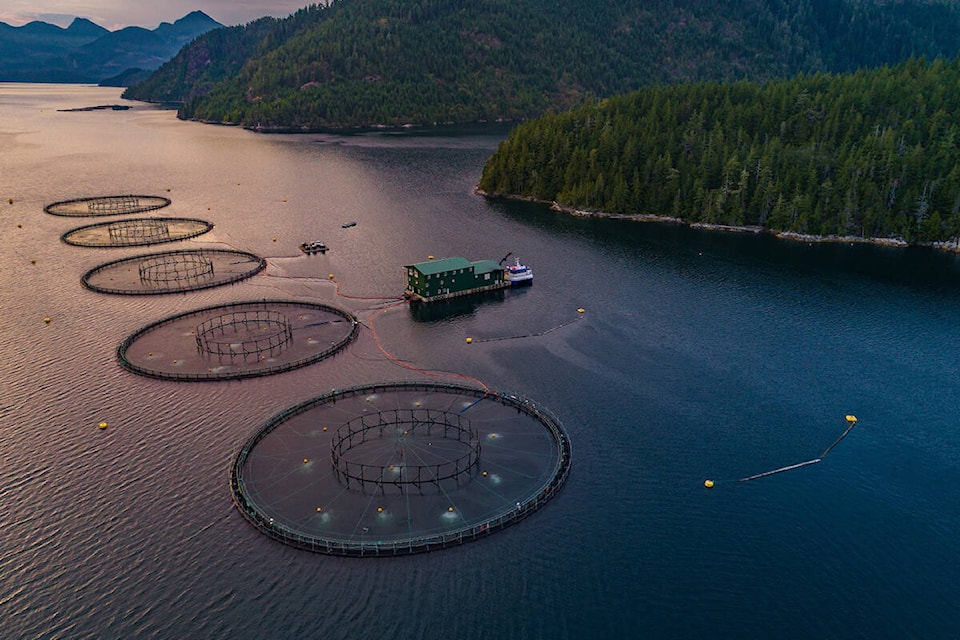Internal documents reveal Ottawa is bracing for major industry players to walk as it phases out open-net pens, leaving closed containment ventures scrambling for salmon eggs.
The federal government is preparing for the possible exit of international salmon farm operations on the B.C. coast following the government’s promise last summer to phase out open-net pen farms by 2029.
If big operators like Mowi Canada West, Cermaq and Grieg Seafood leave the province — shuttering broodstock hatcheries in their wake — that could put closed containment salmon farms in a tough position, cut off from their supply of Atlantic salmon eggs, an internal memo obtained by Canada’s National Observer through a federal Access to Information request shows.
The three multinational companies that own the majority of aquaculture licences on the coast have indicated the “timelines of the aquaculture transition plan are insufficient” to make the shift to closed containment facilities, according to a Feb. 2 memo to Department of Fisheries and Oceans Deputy Minister Annette Gibbons.
“Should these producers leave B.C., they would likely terminate their local broodstock along with their farm operations,” the memo said.
New companies wishing to apply for a closed containment licence would need to import eggs from outside the province — either from Atlantic Canada or overseas — which hasn’t typically been done due to the risk of introducing new diseases to B.C. waters.
“Importing eggs has been identified as a key issue to the [closed containment] sector's success,” the memo said.
Salmon Evolution, a Norwegian land-based salmon farming company, is looking to expand its operation in North America, including B.C., the document said. The company has been actively searching for a site on the West Coast for several years to build a large-scale, land-based salmon farm.
The company is in “advanced negotiations for a high-potential site in North America,” that meets its system requirements, according to the firm’s 2024 annual report, although B.C. was not confirmed as the location.
Site verification and relevant regulatory approval processes will take two to three years, after which the plan is to build a full-scale facility similar to its “Indre Harøy” operation, which is expected to produce 36,000 tonnes of processed fish annually.
Southern B.C. and northern U.S. states were identified by the company as desirable locations since the salmon farming industry infrastructure and value chain is already established. The company said last year it hopes to begin construction as early as 2026.
However, it seems significant obstacles need to be overcome.
To date, the Canadian Food Inspection Agency (CFIA) does not allow the import of live Atlantic salmon or eggs from countries such as Norway, Iceland or the United Kingdom, due to the threat, in particular, of importing infectious salmon anaemia to the province.
CFIA aquatic animal health policy dictates import risks “must be negligible or mitigated to a negligible level to ensure that disease is not introduced through import into Canada,” the document notes.
The memo goes on to discuss two potential complex, lengthy routes BC containment salmon farm operators could take to apply for permits and permissions to safely import Atlantic salmon eggs.
One potential way would be to transport Atlantic salmon eggs from Eastern Canada (where ISA exists) — if a facility obtains CFIA authorization as a “compartment” equipped with appropriate bio-security practices and is granted elevated “health status” beforehand.
The second potential option would be for CFIA to consider negotiating an export certificate for Atlantic salmon eggs from a country like Norway, or for the salmon farm operator to establish specific commodity import conditions.
Open ocean-pen aquaculture operations have been a decades-long point of contention for First Nations, the industry, wild salmon conservationists and the provincial and federal government. However, last June, the federal government announced it would shift to land or marine-based closed containment salmon farms and allow a five-year window for existing operators to make the transition. Any new salmon aquaculture licences would only be issued to closed containment systems for a period of nine years.
The federal government, acknowledging the increased investment costs associated with the new technology, said it would provide support for the transition, but did provide details about who would get support or the form it would take.
The BC Salmon Farmers (BCSF) association said the ban on ocean open-net pens by 2029 isn’t feasible.
“We have repeatedly stated that it is unrealistic and unachievable,” said Michelle Franze, BCSF communications manager in an email.
However, BCSF did not clarify if industry players plan to attempt a transition to closed containment, exit B.C. or shut hatcheries with the aquaculture transition.
BC stands to forfeit $ 1.1 billion in economic activity tied to net pen salmon farming along with 4,500 full-time jobs in Canada, according to BCSF.
Net pen operators also produce an estimated 50,000 tonnes of salmon in BC annually. In contrast, no closed containment systems worldwide have come close to matching those volumes, the email said.
Last year, Salmon Evolution reported harvesting 4,900 tonnes of salmon at its Norway operation — more than double the previous year’s amount. The company is aiming to scale up operations and eventually produce 100,000 tonnes annually once phase two of its Norway facility finishes construction, and proposed operations in North America and Korea get underway.
Canada’s National Observer also reached out to the federal fisheries ministry, MOWI, Cermaq, and Salmon Evolution with questions and interview requests.
They did not respond before publication deadline.
Rochelle Baker, Local Journalism Initiative, Canada's National Observer
